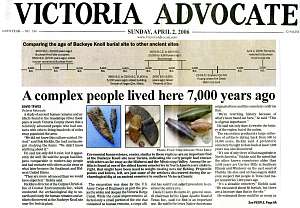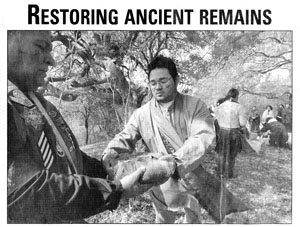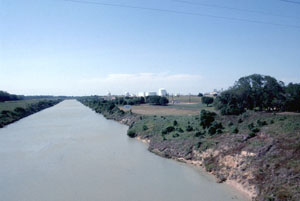Buckeye Knoll
A recently investigated cemetery dating to about 5300-4200 BC has revealed the existence of a relatively sophisticated and populous Early Archaic culture in the lower Guadalupe River Valley. Although only a portion of the Buckeye Knoll site (41VT98) has been excavated, the Buckeye Knoll cemetery is believed to have held at least 200 individuals, making it one of only three large mortuary sites known in North America that date 7,000-8,000 years ago. Among the varied grave offerings were elaborately ground and polished stone artifacts, such as bannerstones, plummets, and grooved quartzite stones, as well as other unusual artifacts made of non-local materials. Lead archeologist Robert A. Ricklis believes the evidence shows that the Buckeye Knoll peoples had extensive interaction with Archaic cultures of the greater Southeastern U.S. Such interaction and the existence of a large cemetery suggest that the hunter-gatherers living in the lower Guadalupe Valley 7,000 years ago were much more numerous and had established territories earlier than predicted by previous explanations.
The Buckeye Knoll site's ground-breaking prehistoric record and its human story is only beginning to emerge, as the analysis and final reporting is still underway. The site was investigated in 2000-2001 as part of a project undertaken by the U.S. Army Corps of Engineers (USACE) to widen and deepen the Victoria Barge Canal, which runs through the lower Guadalupe River Valley and connects chemical plants south of Victoria to the Intracoastal Waterway. The archeological investigations were carried out by a research team led by Ricklis from the consulting firm Coastal Environments, Inc, under contract with the USACE.
Controversy arose over conflict between scientific priorities and those of various Native American groups as well as the DuPont Corporation (now Invista) that owned the land containing the site. One of the concerns was the difficulty (or impossibility) of demonstrating ancestral relationships between the Indian tribes who lived in the area 7,000 years ago and those Indian groups that stepped forth to declare an interest in the Buckeye Knoll cemetery.
The case attracted national, statewide, and local attention. And it all boiled down to whether the human bones and the grave goods would be reburied, with or without scientific study. After protracted negotiations involving federal and state agencies, federally recognized tribes, other Indian groups, a private corporation, and archeological organizations, a compromise was reached. The archeological team was given several years to study the remains and conduct scientific analyses.
In April, 2006, the human remains and associated grave goods were reburied by members of the Lipan Apache Band of Texas and the Invista Corporation. From a scientific perspective, it is very doubtful that any Indian peoples speaking any of the Athapascan languages (such as Lipan Apache) are actually descendants of those who were buried at Buckeye Knoll. From the perspective of many Native Americans today, all prehistoric human remains and grave offerings belong in the ground where they were laid to rest.
We are very hopeful that the full story of Buckeye Knoll will be told on Texas Beyond History. It is a remarkable prehistoric site of continental significance that is changing our understandings of hunter-gatherer life on the South Texas Plains. Unlike that of the nearby Morhiss Mound site, the investigation of Buckeye Knoll will reach proper and relatively timely conclusion.
Learn More:
See related TBH exhibits and ancient places: Morhiss Mound, Loma Sandia, and Guadalupe Terrace sites.
Two articles published on April 2, 2006 in the Victoria Advocate tell more about Buckeye Knoll site and the reburial ceremony.
"A Complex People Lived Here 7,000 Years Ago," by David Tewes, reports on the Buckeye Knoll
archeological findings.
Download Article 
"Restoring Ancient Remains: Corporate America Helps Return Ancestors to their Homes," by Patrick
Brendel, reports on the Buckeye Knoll reburial ceremony.
Download Article 
Replicas of some of the unusual Early Archaic grave offerings found at Buckeye Knoll are on display at the Museum of the Coastal Bend in Victoria.

|

|
